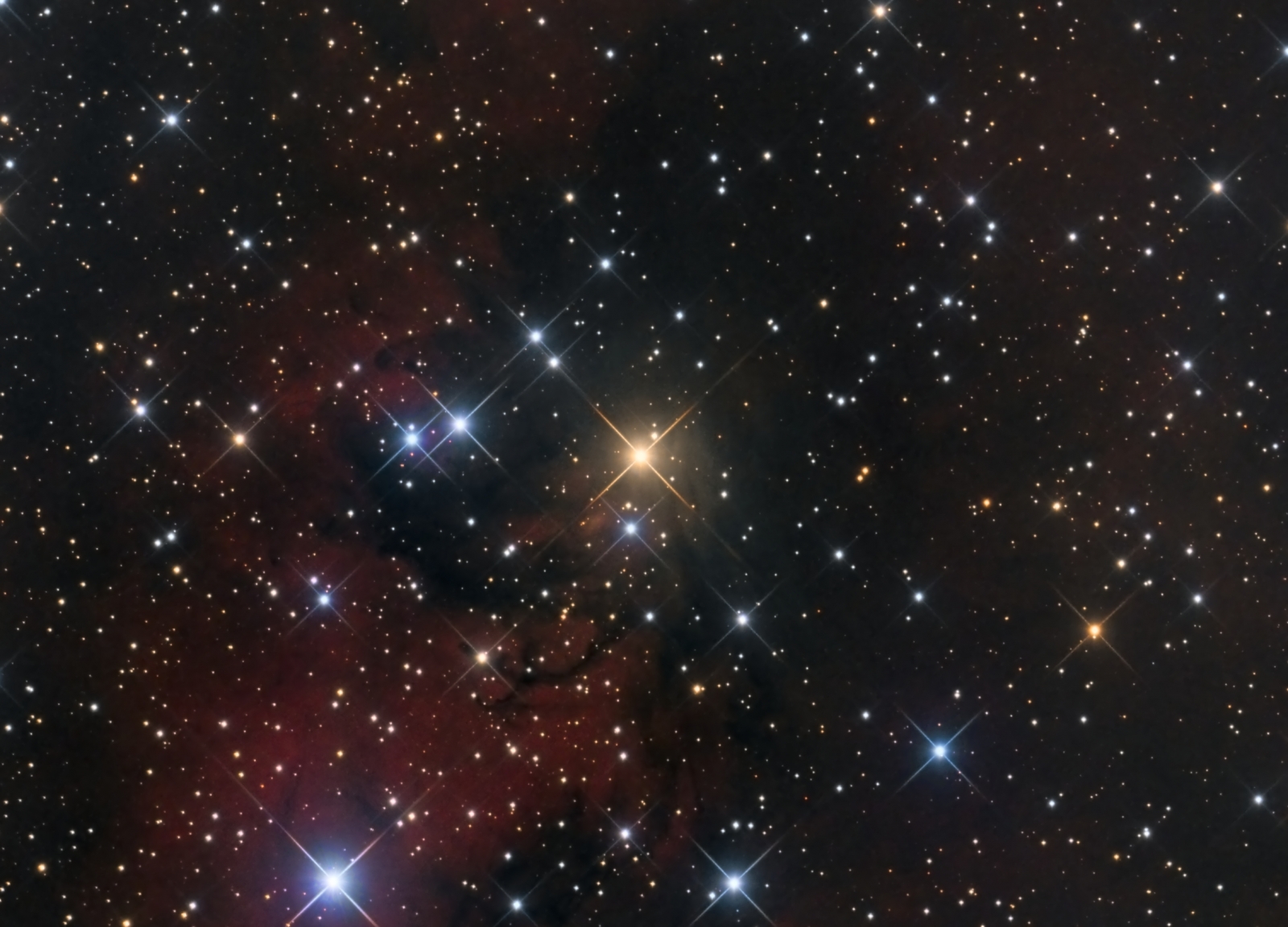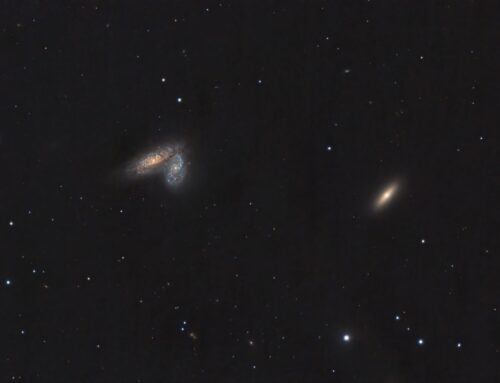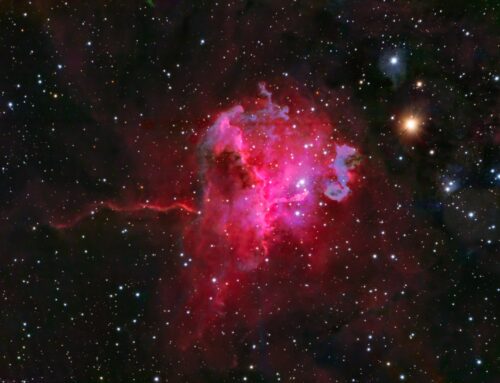vdB 136, Yellow Reflection Nebula
 Click image for full size version
Click image for full size version
August 28, 2015
This image shows an unusual yellow reflection nebula, the first I have imaged. Light from the red giant star in the centre is being reflected in our direction by particles of soot and gas behind the star, giving the diffuse yellow glow of vdB 136. The area is surrounded by faint H-alpha emissions and interesting dark lanes too. This patch of sky lies about 2 degrees from the Cygnus the Swan’s brightest star, Deneb. vdB 136 is a around 2510 light years away, a little further than the various other objects that I have recently imaged in and around Cygnus. For a sense of scale, vdB 136’s approximate diameter is 1/15th the width of the full moon (though it’s nebulous and it is hard to tell where it ends). Another fine yellow reflection nebula is Rho Ophiuchus, but it is too low for me to image from my observatory.
The vdB catalogue was compiled by Sidney van den Bergh and published in 1966. It contains 159 reflection nebula north of -33 degrees declination (so mostly accessible to me). Some vdB objects are part of more famous objects like the Pleiades and the Elephant’s Trunk Nebula in IC1396.
Tekkies:
SBIG STL-11000M camera, Baader Ha, R, G and B filters, 10″ f/6.8 ASA astrograph, Paramount MX. Guided with STL-11000’s external guider and 80 mm f/6 Stellar-Vue refractor. Acquisition and guiding with TheSkyX. Focusing with FocusMax. Automation with CCDCommander. Calibration, cosmetic correction, registration, integration and all processing in PixInsight. Shot from my SkyShed in Guelph, Ontario. Very little moon with good to very good transparency and average seeing throughout acquisition.
20x15m R, 20x15mG, 20x15mB and 18x30m Ha unbinned frames (total=24hr).
HaRGB
Creation and cleanup: Ha, R, G and B masters were cropped and processed separately with ABE. R, G and B were combined to make an RGB image which was processed with DBE and ColourCalibration. The NB-RGBCombine Script was applied with default settings to produce a linear HaRGB image.
Linear Noise Reduction: MultiscaleLinearTransform was used to reduce noise in the background areas. Layer settings for threshold and strength: Layer 1: 3.0, 0.38 Layer 2: 2.0, 0.25 Layer 3: 1.0, 0.15 Layer 4: 0.5, 0.1
Stretching: HistogramTransformation was applied to make a pleasing yet bright image. TGV Noise was applied and the image was re-stretched to reset the black point.
Synthetic Luminance:
Creation and cleanup: The cleaned up Ha, R,G and B masters were combined using the ImageIntegration tool (average, additive with scaling, noise evaluation, iterative K-sigma / biweight midvariance, no pixel rejection).
Deconvolution: A copy of the image was stretched to use as a deconvolution mask. A star mask was made from unstretched SynthL to use as a local deringing support. Deconvolution was applied (100 iterations, regularized Richardson-Lucy, external PSF made using DynamicPSF tool with about 20 stars; local deringing at 70% and global dark deringing at 0.02).
Linear Noise Reduction: MultiscaleLinearTransform was applied to reduce the noise. Layer settings for threshold and strength: Layer 1: 3.0, 0.38 Layer 2: 2.0, 0.3 Layer 3: 1.0, 0.2 Layer 4: 0.5, 0.1
Stretching: HistogramTransformation was applied to make a pleasing yet bright image. TGV Noise was applied and the image was re-stretched to reset the black point.
Combining SynthL with HaRGB:
The luminance channel of the HaRGB image was extracted, processed and then added back into the HaRGB image as follows:
1. Extract luminance from the HaRGB image.
2. Apply LinearFit using SynthL as the reference.
3. Use ChannelCombination in Lab mode to replace the HaRGB’s luminance with the fitted luminance from step 2.
4. LRGBCombine was then used to make a SynthLHaRGB image.
Final Processing
Star shapes were smoothed and sizes reduced by applying MorphologicalTransformation twice through the same star mask. The first pass used the Midpoint operator, with default settings. The second pass used the Erosion operator with a strength of 0.17 and 4 iterations. A light UnsharpMask was applied to the stars.
The DarkStructureEnhance script was applied with a strength of 0.2
Overall contrast was increased and brightness increased slightly with the Curves tool. Saturation in nebula and stars was increased slightly. A final pass of TGV noise was applied only to the darkest portions of the image.
Image scale is about 1.1 arcsec per pixel for this camera / telescope combination.






Hi Ron,
Now that’s an interesting one! Great shot
Mark
Very Nice, at the moment I am trying to make this picture. (vdb136)
It is in Zenith at the moment at midnight.
So maybe it is possible.
Regards Hugo Amsterdam
Damn,5 yrs after and i just saw this one,guess it slipped through the cracks…but a really nice shot Ron!! THX for sharing your work,its appreciated,keep up the good work & be good & be safe.
Dan